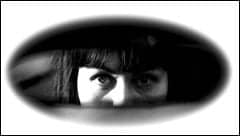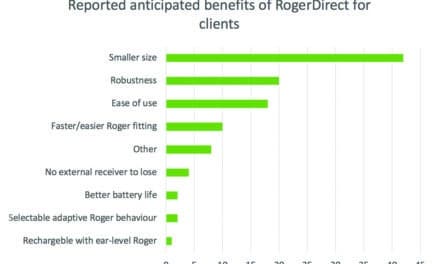Editor’s note: Alan Ruskin’s feature on hearing loss and tinnitus in the military (“Armed Forces Battle Invisible Disability,” May/June Hearing Products Report) drew some letters from readers, including one from Murray Grossan, MD, an ENT in Southern California (read it here). In his correspondence, Grossan outlined a unique tinnitus treatment he has developed, and as a result, Ruskin spoke with him to get more insight into the technique.
—WC

|
It’s been 22 years since Murray Grossan, MD, Diplomate, American Board of Otolaryngology, published the first article on electromyography (EMG) for tinnitus, which resulted from the technique he developed earlier in the 1970s. The tools of his tinnitus treatment? A mirror, biofeedback machine, and relaxation.
Such a retro process might bring to mind an era of the disco ball and pet rock, but for Grossan his way of managing tinnitus is as relevant now as it was then.
Grossan, who practices at Cedars-Sinai Medical Center in Los Angeles, developed the mirror biofeedback process in an effort to reduce the anxiety level of people suffering from tinnitus. Many patients develop anxiety reinforcement, which Grossan compares to a bad case of poison ivy. “The more it itches, the more you scratch, the more nervous you get, and the more it itches. The anxiety reinforces the symptoms and makes the person sicker.
“If you reduce the anxiety reinforcement aspect of tinnitus early, the buildup of further reinforcement can be prevented,” Grossan says. “You don’t actually cure the condition, but rather reduce the factors that increase symptoms.”
In the procedure, patients sit in front of a mirror and observe their face, particularly the frontalis muscles above the eyes in the lower forehead. They also watch their jaws and shoulders, the idea being to get all of these areas as relaxed as possible. The EMG machine projects the muscles’ electrical output onto a screen, and by observing the output, the patient can learn to relax in order to lower the number on the screen.
“When muscles are relaxed,” Grossan says, “you don’t have anxiety,” a notion familiar to anyone who exercises sufficiently. Grossan cites two psychologists (Wolper and Lazarus), who determined that when you have muscle relaxation, you can’t have anxiety. “The relaxed state tells the limbic system that you’re not facing a tiger,” says Grossan.
Specifically, the patient is instructed to inhale to a count of four and exhale to a count of six. The exact timing is not as important as making sure that the exhalation is longer than the inhalation. “Inhalation is a muscle contraction—the shoulders rise, the diaphragm contracts, and so on. Exhalation is a relaxation of the diaphragm, shoulders, and chest muscles. By making exhalation longer, you are in a muscle relaxation mode longer,” he says.
During the exhalation, the patient observes himself in the mirror and signals his body to relax—starting with the forehead, then the face, jaw, and shoulders. The patient should be able to see his muscles relax. “Your jaw should open because the facial muscles are relaxed. The mirror tells you if you’re doing it right.”
Grossan believes that his method should begin as soon as possible after the onset of tinnitus in order to give the patient hope and encouragement. “It’s important that it be used on the first visit. All you need is a mirror. An important aspect of the therapy is that it gives the patient a protocol he can follow and allows him to take an active role in his treatment.”
Regarding treatments that use music, Grossan believes that utilizing music is a good approach, but he prefers using music with lyrics rather than straight instrumentals because the vocals provide more masking of the tinnitus disturbance. In this, he sees an advantage over the Neuromonics musical system featured in the May/June article in that a patient is required to use it for an extended period each day, whereas the mirror biofeedback technique requires just 10 minutes per day.
As for effectiveness, Grossan is quick to admit that quantifying results can be difficult because tinnitus is basically a subjective ailment—the doctor or audiologist cannot hear the ringing sound that the patient hears, and thus measuring it is dependent on the patient’s verbal or written input. However, based on that input, and assuming the patient is diligently doing the required exercises, Grossan says he has found his technique to be 80% effective.
Patients whose anxiety had exaggerated or reinforced their tinnitus did very well after six sessions. The tinnitus either stopped or was significantly reduced. However, when these same patients were tested, they identified their tinnitus levels at the same tones and volumes as in pretreatment testing. “Hence, the tinnitus itself was unchanged, but the reduction of anxiety reinforcement had corrected many of the symptoms,” Grossan says.
The 20% who fail to respond are offered other options, including performing the same therapy procedure under supervised laboratory conditions.
Grossan stresses that the important thing to understand about mirror biofeedback as a treatment for tinnitus is that it’s a physiology-based, rather than psychology-based, system. “When muscles are relaxed, you can’t have an adrenaline reaction,” Grossan says, which reduces tinnitus reinforcement and its symptoms.
Grossan also has a medicinal approach for those who don’t respond adequately to biofeedback, and for tinnitus sufferers in general. He has formulated EarAid, a capsule combining 15 products that the body uses to maintain hearing and health, including supplements and herbs such as N-acetylcysteine, alpha-lipoic acid, butcher’s broom, methylcobalamin, folic acid, coenzyme Q-10, selenium, and other antioxidants.
The product, Grossan says, works on all three parts of the hearing process: the ear that picks up the sound and converts it to electrical impulses, the nerves that carry messages from the ear, and the brain that interprets these signals.
“With modern techniques, we know that it is necessary for all three parts to work together. Therefore, it’s not enough to consider just the ear alone. For example, someone can have tinnitus with normal hearing, or the brain and ear can be healthy, but the person doesn’t hear well because of a nerve weakness. Any impingement of the eighth nerve can result in hearing problems, including tinnitus,” Grossan says.
Grossan says his EarAid product works primarily through its antioxidant action, as well as by providing aids to mitochondria, circulation, and nerves. “Removing free radicals—the oxidative products that can impair ear function—can assist hearing, especially over the long term.”
Grossan lists many possible causes of tinnitus, including acoustic trauma, otosclerosis, otoacoustic neuroma, drug otoxicity, presbycusis, Meniere’s disease, and hypertension. There are other researchers, such as R.A. Levine, MD, who believes that tinnitus can be caused by disorders of the head and upper neck through “activation of the somatosensory system,” and A. Bjorne, MD, has established that in patients with temporomandibular joint (TMJ) dysfunction, tinnitus and vertigo were common along with muscular tension in the jaw and neck. Bjorne determined that injection of lidocaine in a jaw muscle reduced not only the muscular problem but the tinnitus as well, which would seem to support Grossan’s approach of reduction of symptoms through muscle relaxation.
With such a broad-ranging potential etiology for tinnitus, Grossan believes in using a “shotgun approach, trying various treatments in the hope that something will work to relieve the patient’s suffering.” In addition to his preferred initial treatment of mirror biofeedback, supplemented by his EarAid formula, Grossan also advocates the use of a diuretic that is used primarily for glaucoma because of its ability to reduce the enzyme carbonic anhydrase, which is responsible for cochlear hydrops, a condition that causes an increase in fluid pressure in the inner ear that can lead to tinnitus. Another recommendation for reducing inner-ear pressure is a salt-free diet and drinking distilled water. Grossan is also currently experimenting with Botox to induce muscle relaxation and anxiety reduction.
The American Tinnitus Association tabulates that there are 50 million people with tinnitus, about 20% of whom actually suffer from the disease, sometimes to distraction.
“But the percentage in the military is much higher,” says Grossan, “because of the bomb blasts.” These people, as well as anyone suffering with this ailment, need to be helped quickly with cognitive therapy, he says, so that their brain learns that the ringing in their ears is not a threat or a danger, that they can control their response, reduce the anxiety, and, as a result, mitigate the symptoms of tinnitus.
Alan Ruskin is staff writer for Hearing Products Report. He can be reached at [email protected].
Tackling Tinnitus
A sampling of products on the market for the treatment of tinnitus
Solace Free Choice

|
Amplisound Hearing Products & Services, Danielson, Conn, offers Solace Free Choice for tinnitus sufferers. This small receiver-in-the-canal BTE includes a four-channel directional digital hearing aid. There is a digital-programmable sound generator, and music input for Bluetooth or direct-wired neckloop. The wearer can select from any array of combinations or independent use of its features. A large volume control wheel makes for accurate sound generator level adjustment.
(800) 835-2001
www.amplisound.com

|
Oasis
Neuromonics’ noninvasive, FDA-cleared Oasis device is customized to the patient’s unique hearing and tinnitus profile. It delivers a customized neural stimulus that promotes neural plastic changes, allowing the brain to filter out the disturbing tinnitus sound. This stimulus is delivered within spectrally modified, customized music, which engages the brain’s emotional response center, the limbic system, and thereby reduces tinnitus-related disturbance.
(866) 606-3876
www.neuromonics.com

|
Hearing Health Micronutrient Supplement
Premier Micronutrient Corporation, Nashville, Tenn, offers its Hearing Health micronutrient supplement designed to reduce tinnitus (ringing in the ear) and provide cellular protection against hearing impairment and balance disorders. Clinical findings indicate that patients receiving the Hearing Health supplement in addition to standard therapy performed better on all measures than those receiving standard therapy alone.
(888) 606-8883
www.mypmcinside.com

|
The Inhibitor
Melmedtronics Inc, Hurst, Tex, offers The Inhibitor, a handheld tinnitus treatment device that delivers an ultrasonic signal in the range of 20 to 60 kHz during the 1-minute application period. It is reported to temporarily inhibit the annoying sound of tinnitus in 70% to 75% of patients treated, with the amount of relief time varying.
(800) 871-4326
www.tinnitustreatment.com

|
RingSTOP
Ear Inc, Boulder, Colo, offers RingSTOP, an all-natural product for people with tinnitus. The product is a homeopathic formula available in capsule form containing amino acids, herbal extracts, antioxidants, and vitamins that have been reported to reduce the symptoms of tinnitus.
(800) 525-2690
www.earinc.com




